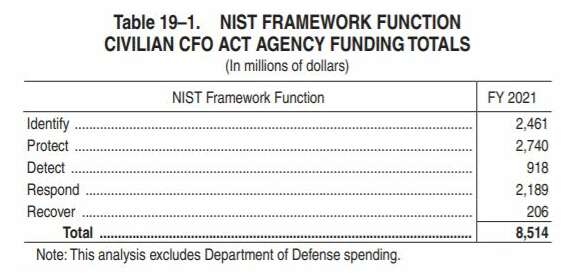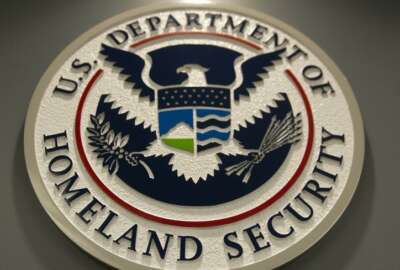
VA, HHS, SBA among biggest winners in $92B IT budget request for 2021
President Donald Trump’s fiscal 2021 budget request includes $125 million for the Technology Modernization Fund and the return of the priority for agencies to...
Best listening experience is on Chrome, Firefox or Safari. Subscribe to Federal Drive’s daily audio interviews on Apple Podcasts or PodcastOne.
The White House is asking Congress for the largest information technology budget ever, driven, in part, by the need to move to shared services and continue the modernization of federal systems and applications.
President Donald Trump’s fiscal 2021 budget request asks for $92.1 billion, up from $91.9 billion in 2020 and $88.7 billion in 2019. Additionally, the White House requested $18.78 billion for governmentwide cybersecurity funding, down slightly from $18.79 billion in 2020.
“What’s really important is those are about not only improving service, but saving money as well. You see investments in shared services continue that helps us save money across agencies on the modernization side. We will continue the savings as we consolidate data centers,” said Suzette Kent, the federal chief information officer, during a call with reporters on Monday. “As we move to best-in-class contracts like Enterprise Infrastructure Solutions (EIS), we are promoting automation and we are seeing great success with automation and robotics process automation. We will continue to fund and expand those. On the data side, there are many priorities that are rooted in the Federal Data Strategy.”
Most of the agencies received increases in their 2021 budget requests over 2020 with some specific exceptions like the Commerce Department, which is expected to be done with Decennial Census.
Source: Both charts come from data in the President’s 2021 budget request.
The Office of Management and Budget continues to push for full funding of the Technology Modernization Fund (TMF). The administration is asking for $125 million for 2021 and the ability to carry over $25 million from 2020.
Additionally, OMB is asking for $11.5 million for the IT Oversight and Reform (ITOR) Fund, which is down from $15 million in 2020.
Kent said part of the reason that the administration is asking for less money for ITOR is it will need less money next year. Part of the reason for that is the U.S. Digital Service is moving toward a fee-for-service model where agencies pay for its services instead of OMB footing the costs.
Add to that, the General Services Administration’s request of $58.4 million for the Federal Citizen Services Fund, which his up from $55 million in 2020, and the administration is asking for more than $195 million for IT modernization.
“When I came in, one of our goals was to get everyone to cloud email. It was at 55% or so governmentwide and now it’s at 76%. So we are moving information faster, with better quality and sharing with other sources to get threat information to help everyone collectively,” Kent said. “Our overarching themes are not different, but the work we are doing is advancing the ball.”
Policy direction is real value in 2021
The IT budget documents give plenty of hints where Kent and her staff want to advance the ball in 2020 and beyond.
The most prominent changes is the calling out of IPv6 in the budget. Agencies have been moving toward this new protocol for the better part of 15 years, but with limited success.
Kent said she is resignaling both the importance of implementing IPv6 as well as highlighting another place to save money. She said it’s expensive for vendors to support a dual stack of IPv4 and IPv6.
Related Stories
GAO’s report on the Technology Modernization Fund puts OMB on the offensive
“To maintain America’s AI advantage, federal agencies are to focus on two distinct areas. The first area of focus is internal—Federal use of AI to better achieve agency missions and serve citizens,” the budget states. “The second focus area is external – including provision of data and related resources to support the private sector and academia in their efforts to harness AI. In both of the these areas, the administration’s policies and strategies aim to accelerate AI innovation to increase our prosperity, enhance our national/economic security, and improve our quality of life.”
A third policy area of focus is another long-standing challenge, the move to shared services.
GSA requested $20 million to transition agencies to the NewPay payroll software-as-a-service (SaaS). Additionally, the departments of Health and Human Services, and Homeland Security have specific budget line items for shared services efforts while the Agriculture and Interior departments are planning projects in 2021 to transition to NewPay.
In addition to NewPay, GSA asked for $8.5 million in interagency contributions to streamline and modernize the federal rulemaking process.
“During the preparation for the 2021 budget, three agencies prepared and presented plans for future services. In addition, exploration and analysis of standards for additional mission support areas will occur in 2020 and 2021,” the budget states.
Cyber funding basically flat
The budget also provided updated details on agency progress in assessing and reducing risk of major IT projects.
OMB says CIO risk ratings for civilian IT projects were more “yellow” than “green” in 2020.
Kent said this shows the complexity of federal IT projects is growing because agencies are moving away from the “low-hanging fruit” modernization efforts.
The administration reduced the governmentwide total for cybersecurity funding in 2021. OMB says agencies still should expect to spend almost $19 billion.
“Agencies estimated cybersecurity budget authority for 2021 reflects planned investments to protect information and information systems commensurate with the risk and magnitude of potential harm. However, a number of agencies also have cybersecurity-related spending that is not dedicated to the protection of their own networks, serving instead a broader cybersecurity mission. For instance, there are a number of programs that provide tools and capabilities Government-wide, such as DHS’s Continuous Diagnostics and Mitigation (CDM) program,” the budget states. “Additionally, numerous programs exist that further enhance national and federal cybersecurity focused on areas such as standards, research, and the investigation of cyber-crimes rather than specific technical capabilities.”
For the first time, OMB broke down how much civilian CFO Act agencies are spending on each of the five areas of the NIST cybersecurity framework functions.

“The spending shows what we are doing and where we need to go,” Kent said. “If we spend a lot on defense, then we will spend less on response. You should see a progression of those numbers where agencies are spending less on response because they are spending more on identify and detect processes. We also can compare agencies with other mature industries in terms of cyber spending.”
Copyright © 2024 Federal News Network. All rights reserved. This website is not intended for users located within the European Economic Area.
Jason Miller is executive editor of Federal News Network and directs news coverage on the people, policy and programs of the federal government.
Follow @jmillerWFED





